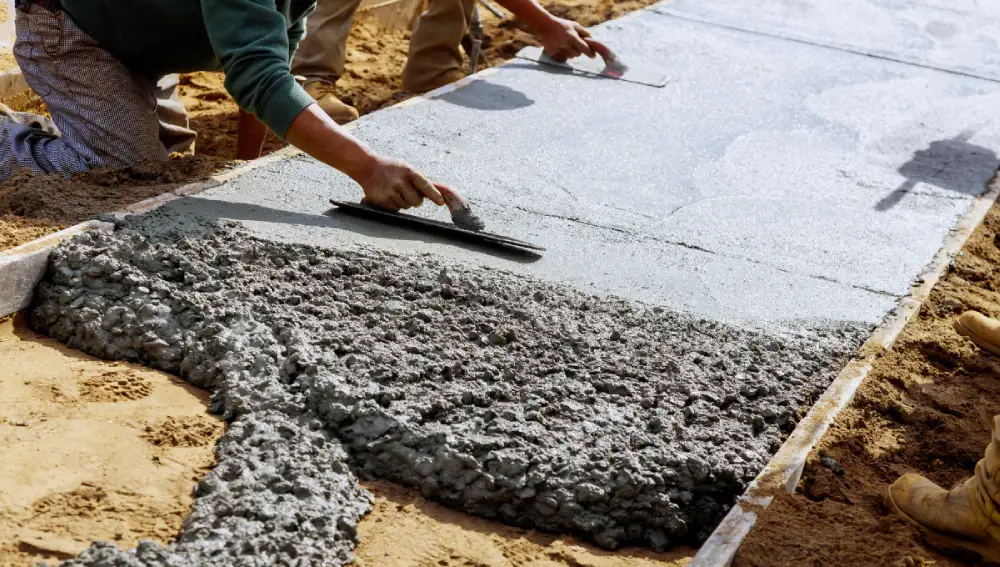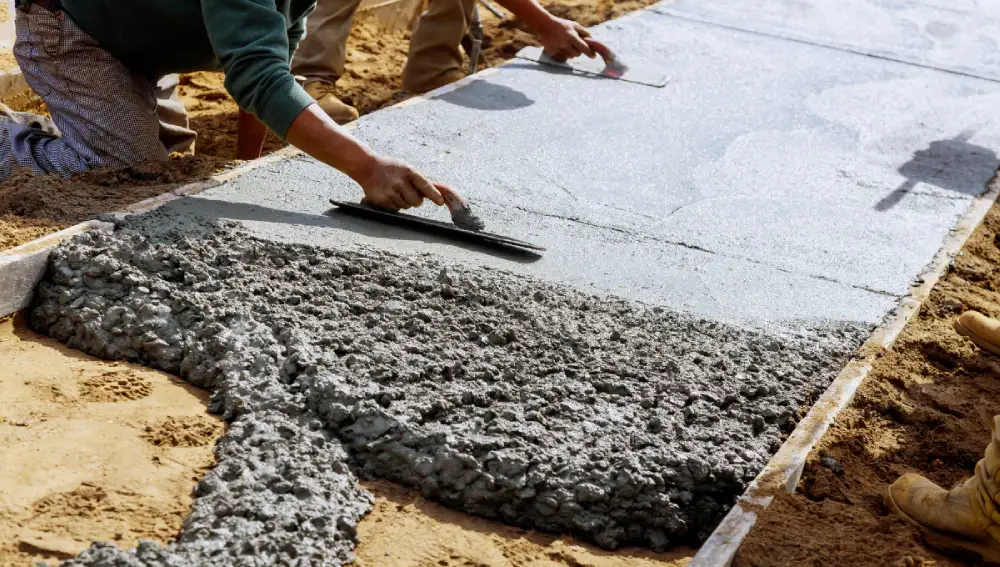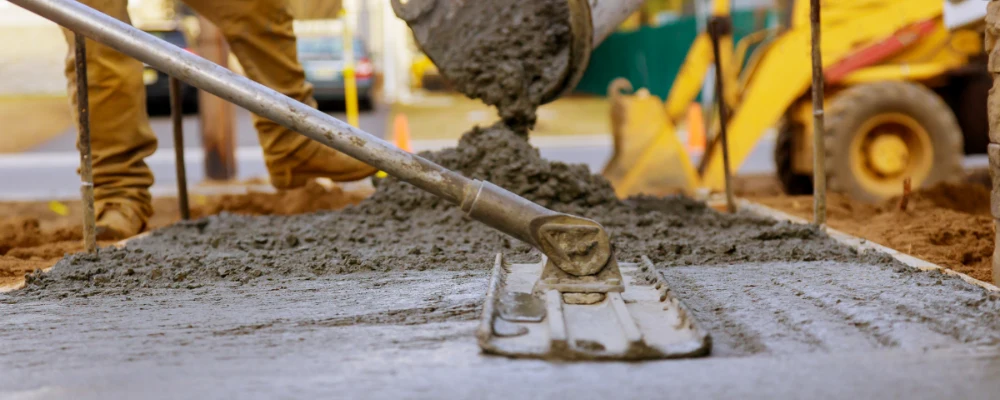Concrete plays a vital role in constructing various type of building, serving as a fundamental building material for centuries . Basically, concrete is made of aggregate particles like sand and gravel which are combined with cement and water. Concrete’s stability is determined by the quality of the cement, sand, and water-to-cement ratio. Plain Cement Concrete (PCC), in simple terms means, is a perfect mix of cement with fine aggregate and coarse aggregate.
In this blog, we will discuss PCC and its crucial role in construction. Keep reading for more details!
What is PCC in Building Construction?

Concrete is an essential material in construction. One notable type is PCC (Plain Cement Concrete). PCC has been used in several construction projects, both small-scale and large-scale. Its major role is to level the surface and avoid laying on sand directly.
What is PCC in Construction?
PCC is a construction material. It is a mix of cement, sand, gravel or crushed stone, and water. It is a basic type of concrete. It is used for many construction purposes, mainly as a structure foundation. PCC is used to make a strong, rigid foundation. It reduces the risk of moisture damage to the structure.
Why is PCC Important in Construction?
PCC plays a crucial role in construction for several reasons:
Foundation Stability:
PCC provides a solid base for structures. It helps spread loads evenly and reduces settlement.
Moisture Barrier:
It blocks moisture. This stops water from reaching the structure and causing damage.
Cost Effectiveness:
PCC is less expensive than reinforced concrete and many advanced materials, making it a cost-effective option for builders.
Durability:
PCC offers long-term durability. It resists weathering and is suitable for different environmental conditions.
Materials Used in Plain Cement Concrete
1. Coarse Aggregate
Coarse aggregates are large particles in concrete, measuring 4.75 mm to 150 mm. Examples include gravel, crushed stone, and crushed slag. They
should be clean, hard, and durable. Proper grading is essential for ensuring good workability and strength.
2. Fine Aggregate
Fine aggregates are smaller particles, usually sand, with a particle size of up to 4.75 mm. Natural sand or manufactured sand.
They should be free from impurities like silt and clay. Which could cause issues with bonding and strength.
3. Cement
Cement is a binding material. It reacts with water to form a hard, solid mass.
Portland cement is commonly used in construction projects. It should meet standard specifications, such as IS 269 in India or ASTM C150 in the US.
4. Water
Water is essential for the hydration process that occurs when mixing concrete. It should be clean and free from impurities that could affect the setting time and overall strength of the concrete.
Mixing Ratios
The common mixing ratio for Plain Cement Concrete (PCC) is typically expressed as 1:2:4, which denotes:
- 1 part Cement
- 2 parts Fine Aggregate (Sand)
- 4 parts Coarse Aggregate (Gravel or Crushed Stone)
This ratio is generally used for various structural components such as foundations, pavements, and other non-load bearing elements. Adjustments to the ratio may be made depending on the specific project requirements, such as load-bearing capacity or environmental conditions, to enhance strength and durability56.
In addition to the standard 1:2:4 mix, other ratios can be utilized for specialized applications:
1:1.5:3 for beams, providing enhanced strength for structural elements.
1:3:6 for sidewalks and floors, ensuring sufficient strength while maintaining workability during placement.
1:0.5:1 for water-retaining structures, focusing on impermeability.
These ratios offer flexibility to meet the various needs of construction projects while ensuring that the concrete remains workable and strong.
Mixing of Plain Cement Concrete

The mixing of PCC involves the following steps:
1. Batching:
Measure the amounts of cement, aggregates, and water accurately. Do it according to the desired mix ratio.
2. Dry Mixing:
Mix the dry ingredients (cement, fine sand, and coarse stones) in a concrete mixer. Space them out to create a balanced layout.
3. Wet mixing:
Wet mix is the Mix in the water slowly. Stir until the blend is the thickness you want.
4. Consistency check:
Check the mix’s flow using the slump test. Optimal consistency ensures success.
Advantages of Using PCC in Construction
- PCC is generally more affordable than RCC (Reinforced Cement Concrete) So, it’s good for basic structures.
- PCC is easy to apply. Its simple mixing and placement do not require specialized skills.
- Low maintenance requires minimal maintenance compared to other types of concrete.
- It provides decent thermal insulation properties, contributing to energy efficiency in buildings.
Disadvantages of Using PCC in Construction
- PCC crumbles under tension, failing as a standalone material for load-bearing structures. Its weakness demands reinforcement to withstand stress. Without added support, PCC proves inadequate for critical structural applications.
- Cracks may develop in poorly designed mixes. Certain conditions increase vulnerability, making careful formulation crucial to preventing fracturing.
- Load Capacity Constraints: Compared to reinforced concrete, this material falters under heavy burdens. Its structural limitations prevent its use in high-stress scenarios.
- Lacking reinforcement, PCC crumbles under shear and bending forces, necessitating additional support in structural applications.
How PCC Works: Dos and Don’ts
Dos:
- Ensure you use the correct mix ratio to achieve the desired strength and durability.
- Maintain proper curing to achieve optimal strength and prevent cracks.
- Regularly test materials and mixes to ensure consistency and compliance with construction standards.
- Handle and transport the concrete with care to prevent segregation and contamination.
Don’ts:
- Avoid over-watering the mix., as this can weaken the integrity and cause segregation.
- Don’t use contaminated materials. Impurities in aggregates or water can affect the quality of the concrete.
- Avoid rapid setting. Ensure there is adequate time for setting and curing to prevent issues such as cracking.
- Don’t neglect cleanliness. Equipment and tools should be clean. This avoids contamination and ensures proper mixing.
PCC vs. RCC
| Feature | PCC (Plain Cement Concrete) | RCC (Reinforced Cement Concrete) |
| Definition | Concrete without reinforcement | Concrete with embedded steel rods |
| Strength | Lower tensile and flexural strength | Higher tensile and flexural strength |
| Application | Foundations, pavements, non-structural elements | Load-bearing structures, beams, and columns |
| Cost | Less expensive | More expensive due to reinforcement |
| Durability | Less durable under tensile stress | More durable and resistant to stress |
Conclusion
Plain Cement Concrete (PCC) is fundamental in construction. It is known for its simplicity and low cost. It provides a strong base for many structural elements. It also keeps out moisture. But, it is not good for high-stress applications because it lacks tensile strength. Knowing the materials used in PCC and the right mixing procedures is crucial for achieving optimal performance. Also, knowing the key differences between PCC and RCC can help in making informed decisions for construction projects. Proper handling, quality control, and best practices are vital. They ensure PCC’s performance and longevity in construction.

